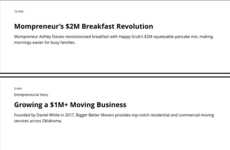
Collaborative Consumption Platform
Tiana Reid — March 30, 2012 — Social Good
SocialBusiness.org discovered Unstash because of our position as a media partner for the Social Innovation Generation (SiG) and the MaRS Discovery District’s 2011 Social Finance Forum in Toronto last December. The business model got me intrigued -- it's essentially based on sharing -- so it's a pleasure that co-founder Lon Wong provided some insight into how he not only got started as a social entrepreneur, but also continues to push the agenda each and every day.
Four Questions with Lon Wong
1. How did the idea for the business model come about?
The idea came long before the business model. unstash is all about peer-to-peer sharing of durable consumer goods, it's one of those ideas that would repeatedly come up beginning with the phrase "Wouldn't it be awesome if..." If I knew who had a tent for coming upcoming camping trip, if I could make better use of this ice cream maker I was given, if someone had a spare guitar amp near by, if I could have access to larger selection of camera lenses through sharing, and so on.
The business model itself has developed over time like many other startups, I assume. We've studied what's worked and hasn't with other companies, attended a number of business-oriented bootcamps, and brought in seasoned advisers along the way. Most of the business model has been refined through direct dialog with individuals and organizations that have been waiting for a solution like ours.
2. How did you decide to join this sector?
It never occurred to me that I was entering the social business sector, I was merely following where I felt my passions and skills intersected with a need in our world. I left some fantastic years in the corporate IT world to work more directly in bringing about change within faith communities and from there I discovered the two worlds didn't need to be mutually exclusive. There's a vast array of ways to directly help people and our planet through sustainable social purpose businesses. It's an exciting time to be alive and creating.
3. How do you get your inspiration?
On inspiration, I'm a natural catalyst. I love seeing connections between things and bringing them together. I'm not without my share of funks though so surrounding myself with crazier doers helps (Though I find this crowd doesn't do much for me when it comes to investing as we're all spent for our dreams and chasing funds). I'm inspired by stories of sacrifice, whether they end in success or failure, they often keep me going.
4. How do you reset yourself to be creative? Do you have any rituals?
Knowing each day is a gift, with a fairly clean slate, helps me stay creative. I'm an avid reader, and stories of all type that push the boundaries makes space for my own imagination to stretch out. For some reason I get an extra thrill working when other's aren't, which means in the early morning or late at night. I've got a number of mantras that I make a habit of reminding myself that help re-align me mentally and emotionally. I find the easiest thing to do each day is everything else but the one thing that matters, which is likely whatever's most daunting, but if I can muster the courage to do that one thing, the rest eventually falls into place. Creativity can come and go, so a big part of it is simply pushing myself to do the work each day, and I find creativity usually shows up when I do my part.
Four Questions with Lon Wong
1. How did the idea for the business model come about?
The idea came long before the business model. unstash is all about peer-to-peer sharing of durable consumer goods, it's one of those ideas that would repeatedly come up beginning with the phrase "Wouldn't it be awesome if..." If I knew who had a tent for coming upcoming camping trip, if I could make better use of this ice cream maker I was given, if someone had a spare guitar amp near by, if I could have access to larger selection of camera lenses through sharing, and so on.
The business model itself has developed over time like many other startups, I assume. We've studied what's worked and hasn't with other companies, attended a number of business-oriented bootcamps, and brought in seasoned advisers along the way. Most of the business model has been refined through direct dialog with individuals and organizations that have been waiting for a solution like ours.
2. How did you decide to join this sector?
It never occurred to me that I was entering the social business sector, I was merely following where I felt my passions and skills intersected with a need in our world. I left some fantastic years in the corporate IT world to work more directly in bringing about change within faith communities and from there I discovered the two worlds didn't need to be mutually exclusive. There's a vast array of ways to directly help people and our planet through sustainable social purpose businesses. It's an exciting time to be alive and creating.
3. How do you get your inspiration?
On inspiration, I'm a natural catalyst. I love seeing connections between things and bringing them together. I'm not without my share of funks though so surrounding myself with crazier doers helps (Though I find this crowd doesn't do much for me when it comes to investing as we're all spent for our dreams and chasing funds). I'm inspired by stories of sacrifice, whether they end in success or failure, they often keep me going.
4. How do you reset yourself to be creative? Do you have any rituals?
Knowing each day is a gift, with a fairly clean slate, helps me stay creative. I'm an avid reader, and stories of all type that push the boundaries makes space for my own imagination to stretch out. For some reason I get an extra thrill working when other's aren't, which means in the early morning or late at night. I've got a number of mantras that I make a habit of reminding myself that help re-align me mentally and emotionally. I find the easiest thing to do each day is everything else but the one thing that matters, which is likely whatever's most daunting, but if I can muster the courage to do that one thing, the rest eventually falls into place. Creativity can come and go, so a big part of it is simply pushing myself to do the work each day, and I find creativity usually shows up when I do my part.
Trend Themes
1. Peer-to-peer Sharing - The trend of peer-to-peer sharing of durable consumer goods presents disruptive innovation opportunities for businesses to create collaborative consumption platforms like Unstash.
2. Sustainable Social Purpose Businesses - The trend of sustainable social purpose businesses offers disruptive innovation opportunities for businesses to create platforms that directly help people and the planet.
3. Catalyst for Change - The trend of being a catalyst for change provides disruptive innovation opportunities for businesses to develop innovative solutions that bring about positive social impact.
Industry Implications
1. Collaborative Consumption - The collaborative consumption industry can explore disruptive innovation by creating platforms for peer-to-peer sharing of durable consumer goods.
2. Social Business - The social business industry can seize disruptive innovation opportunities by incorporating sustainable social purpose into their business models.
3. Faith Communities - The faith communities industry has the potential for disruptive innovation by embracing sustainable social purpose businesses that directly help people and the planet.
3.7
Score
Popularity
Activity
Freshness























